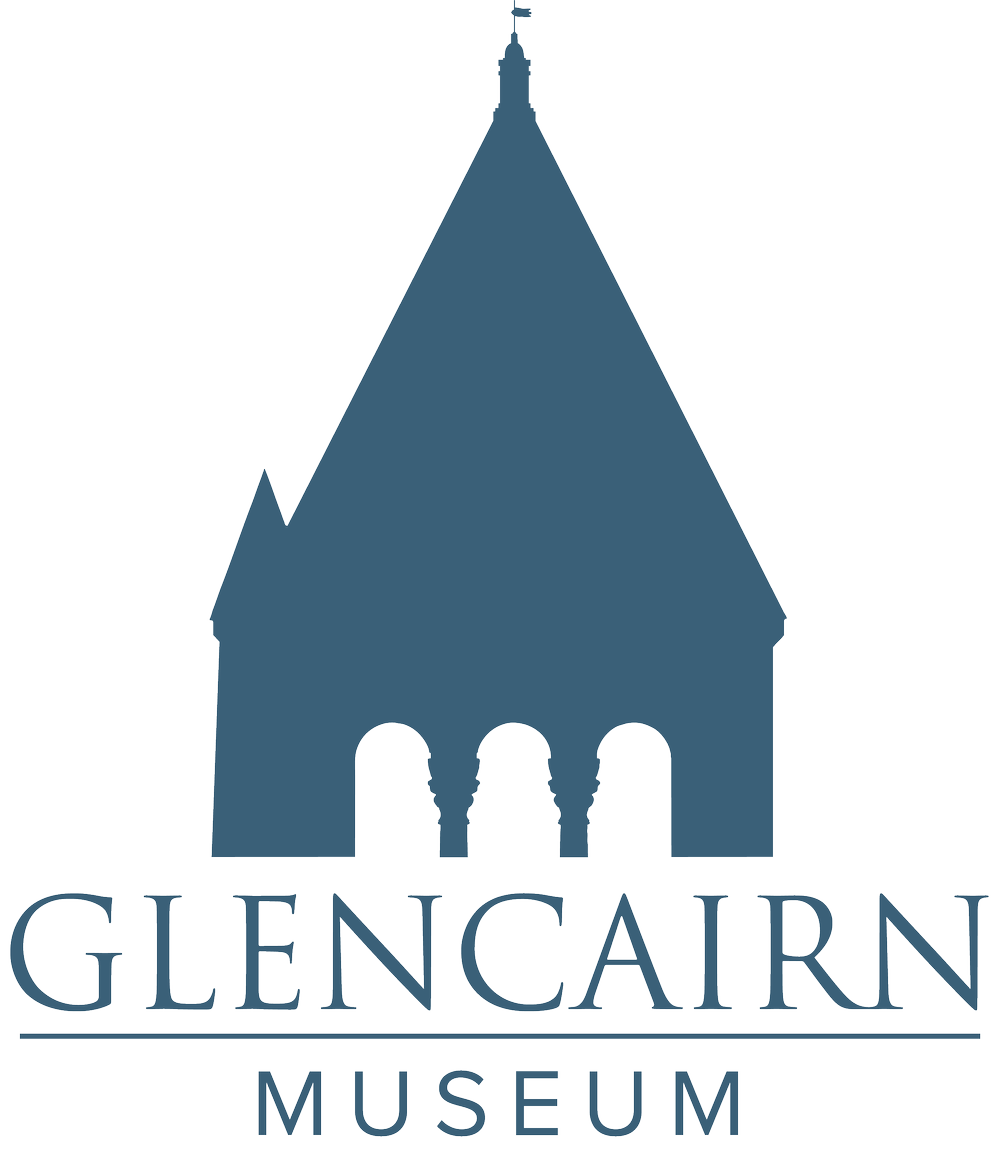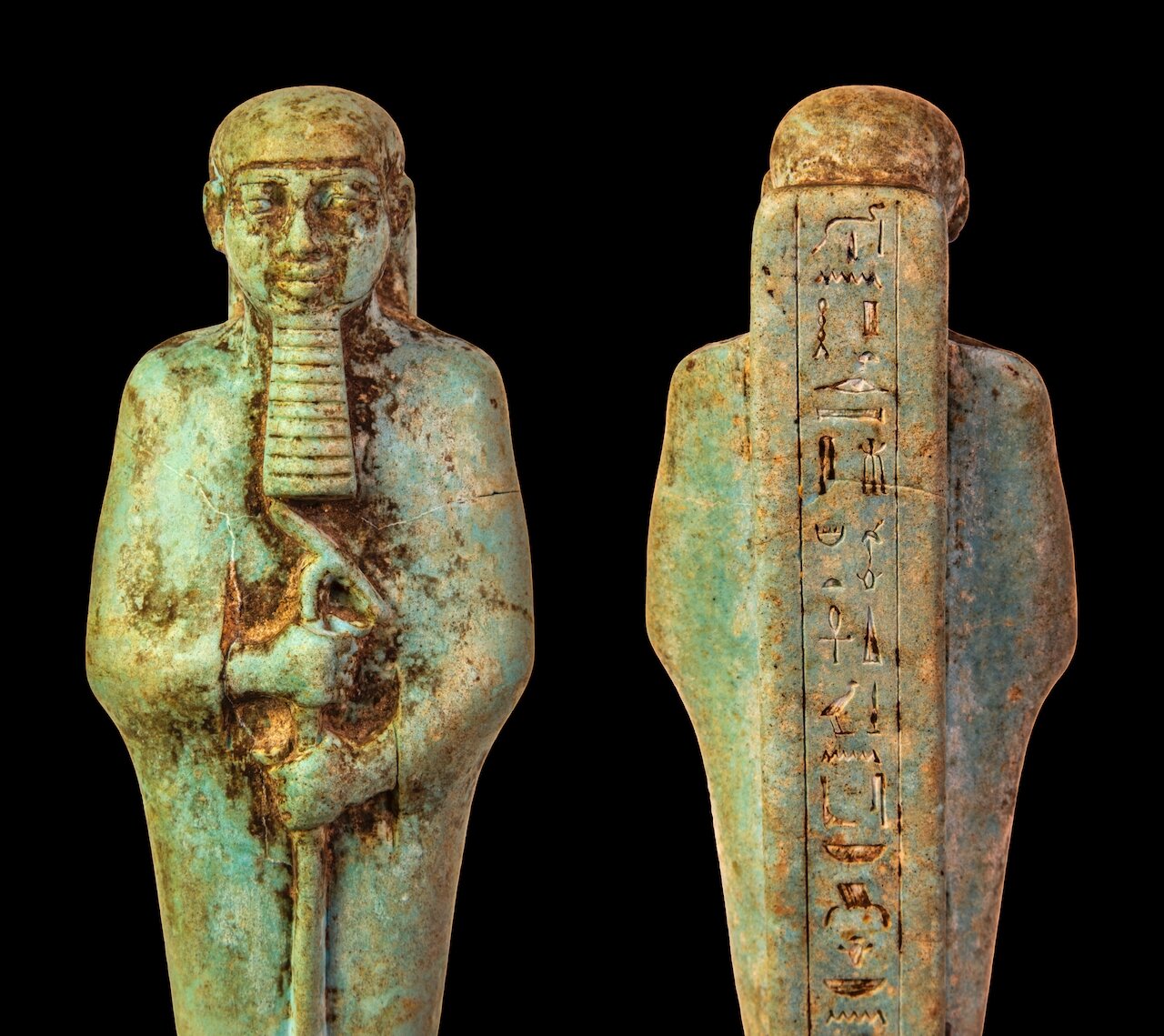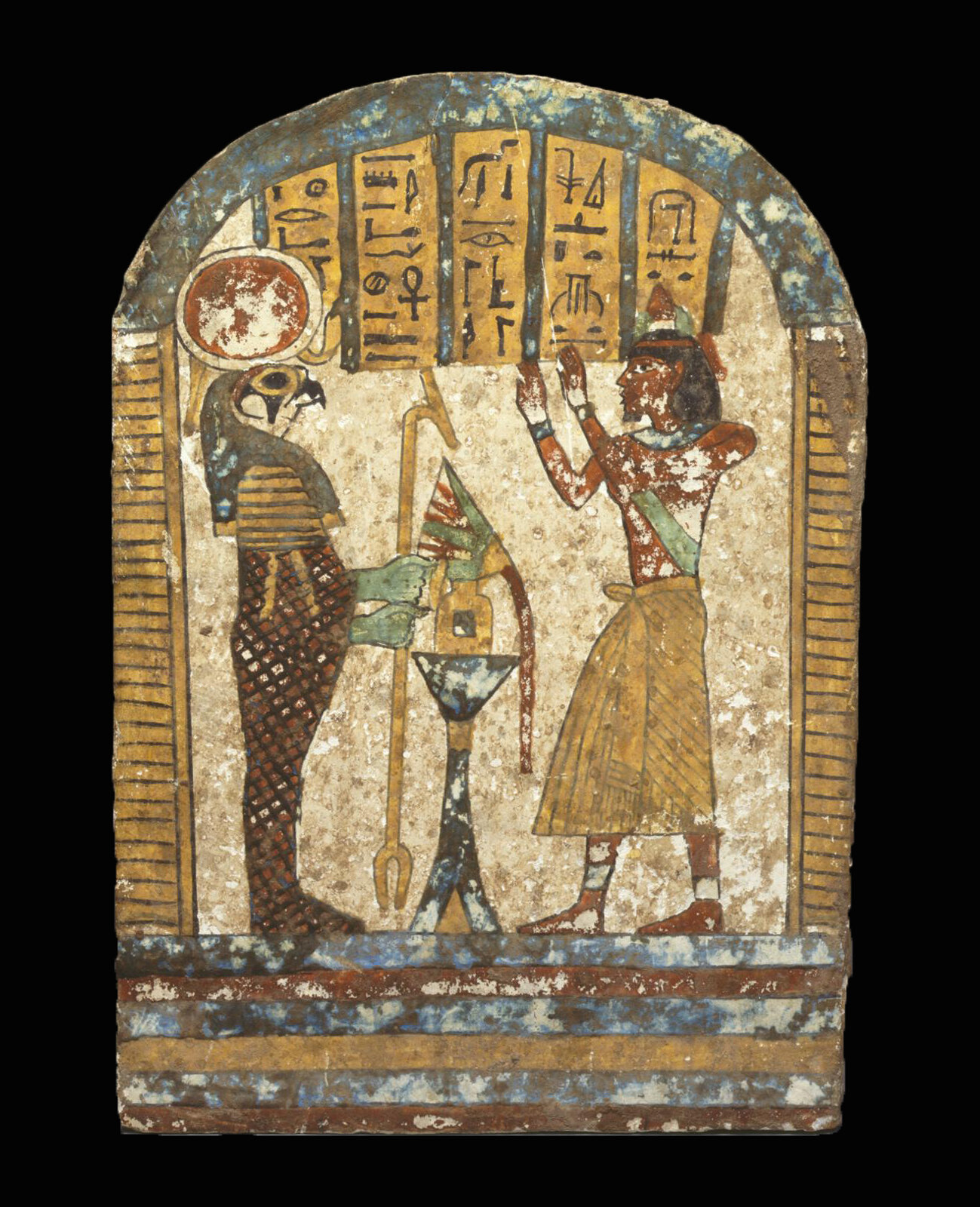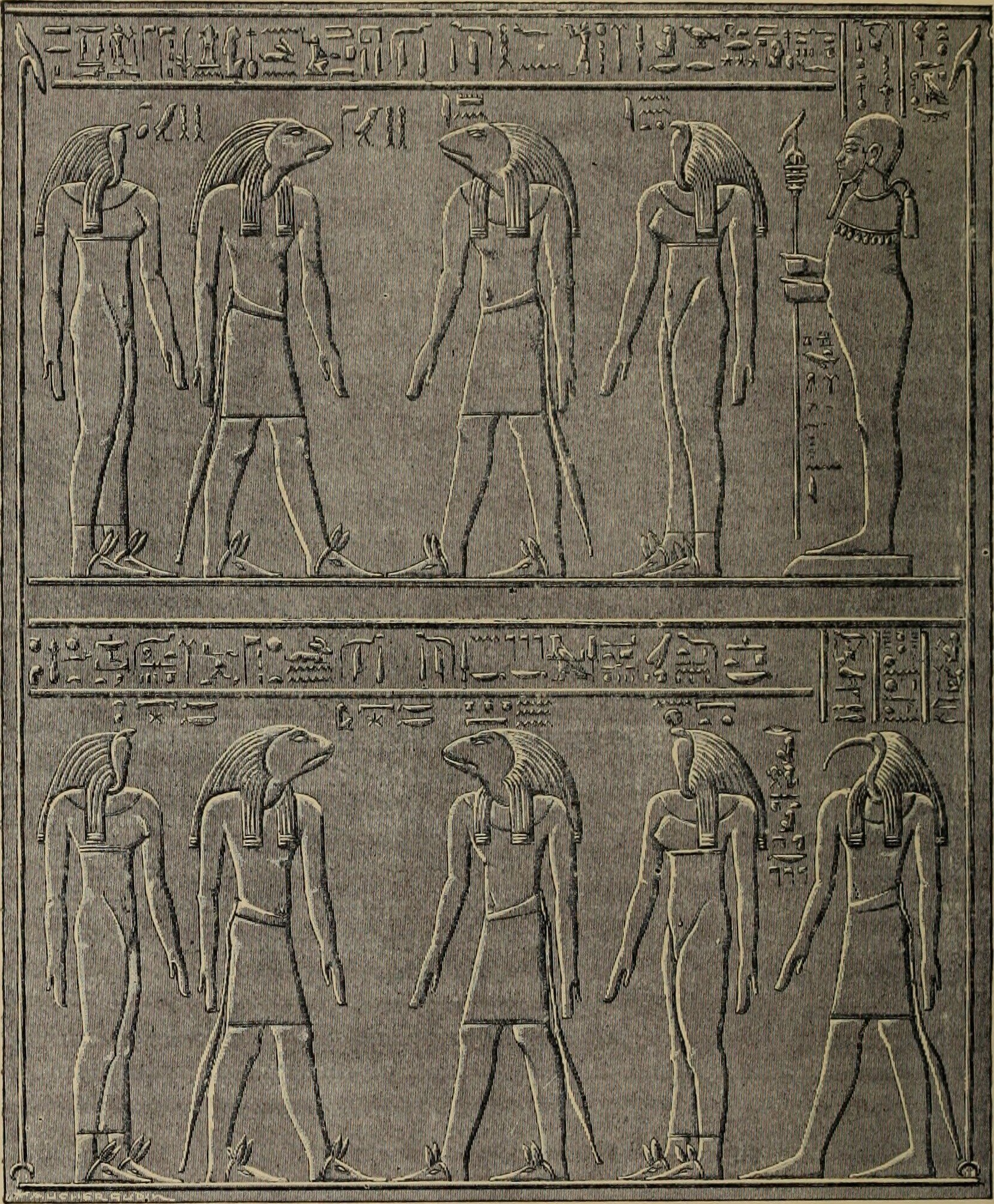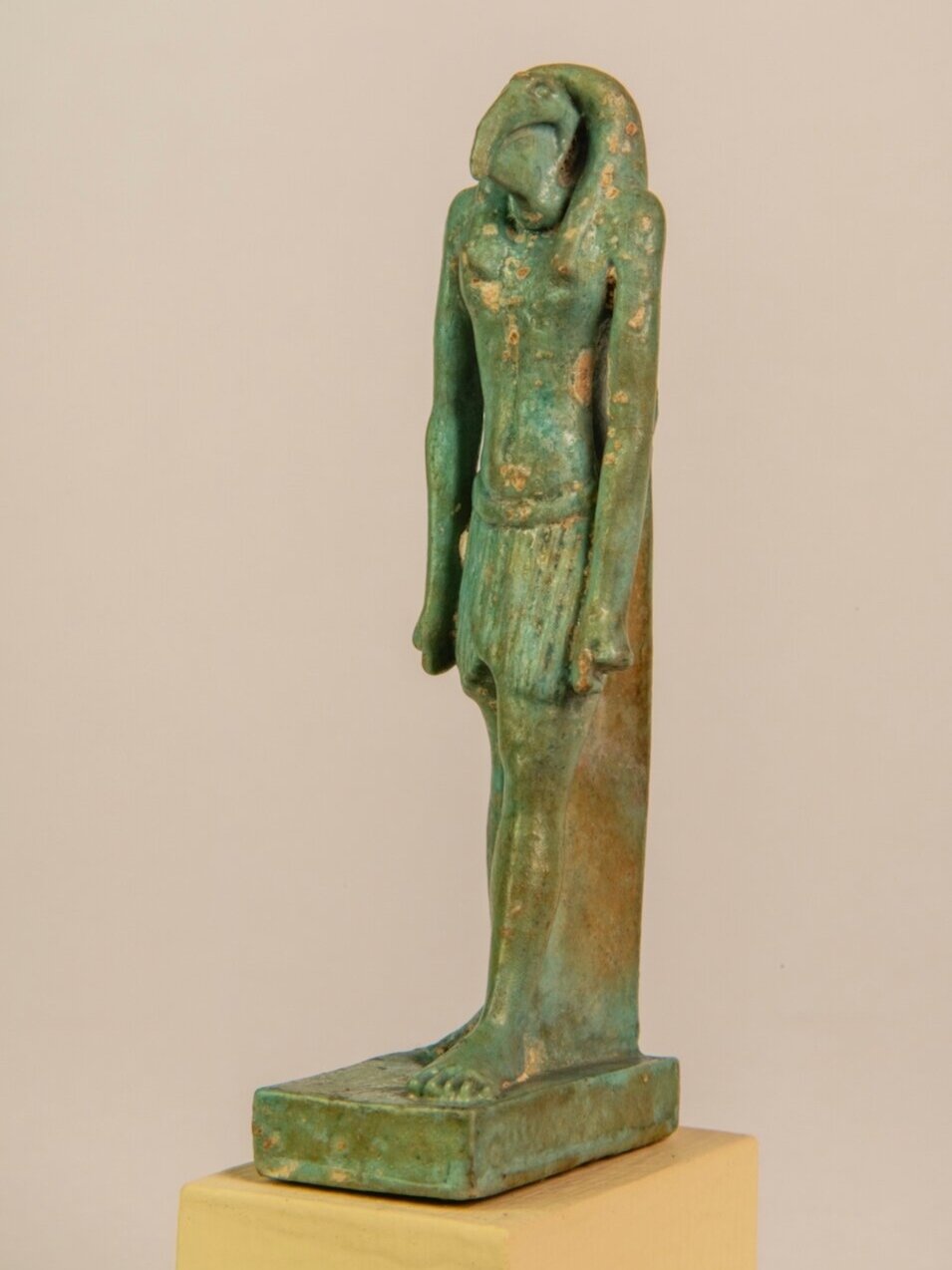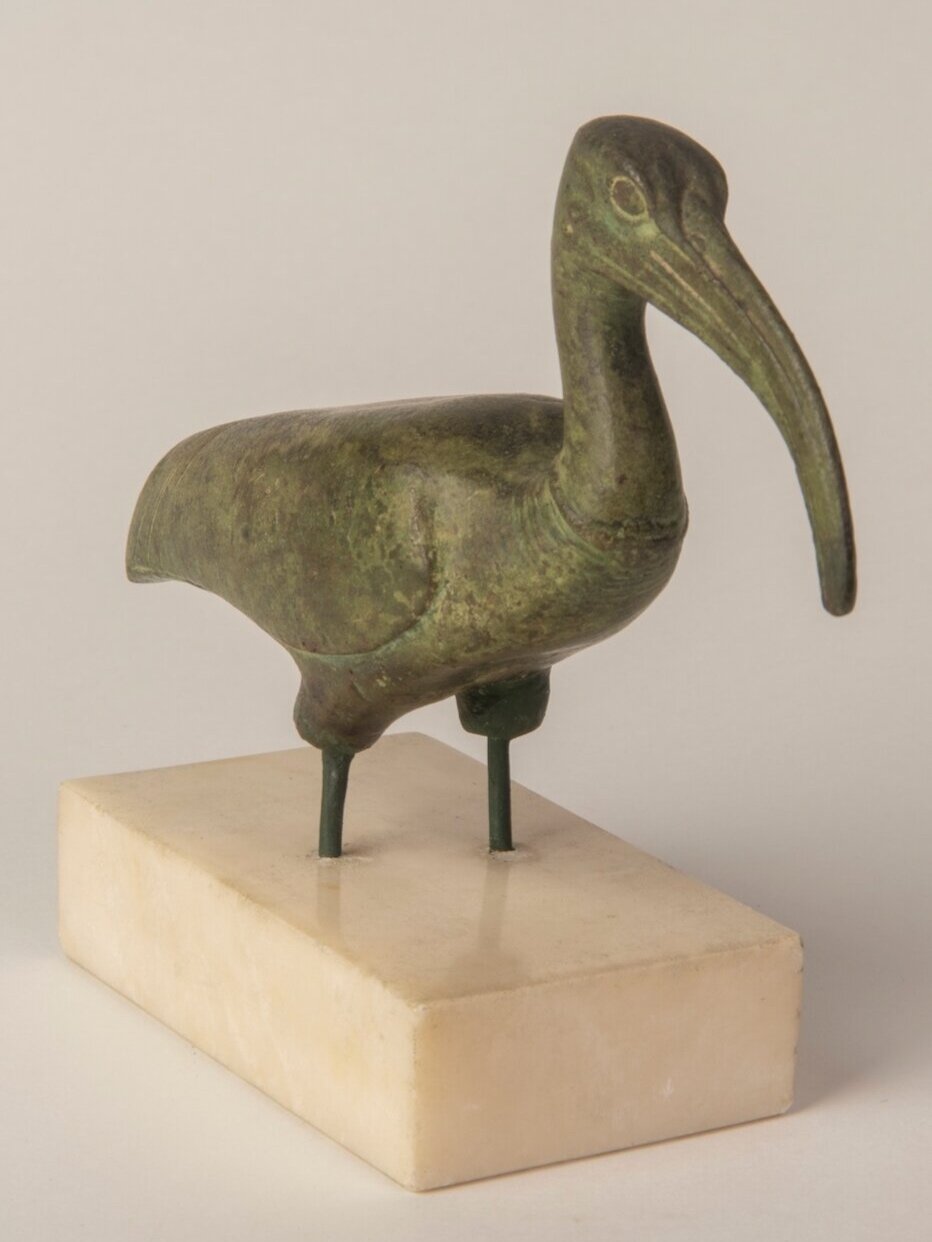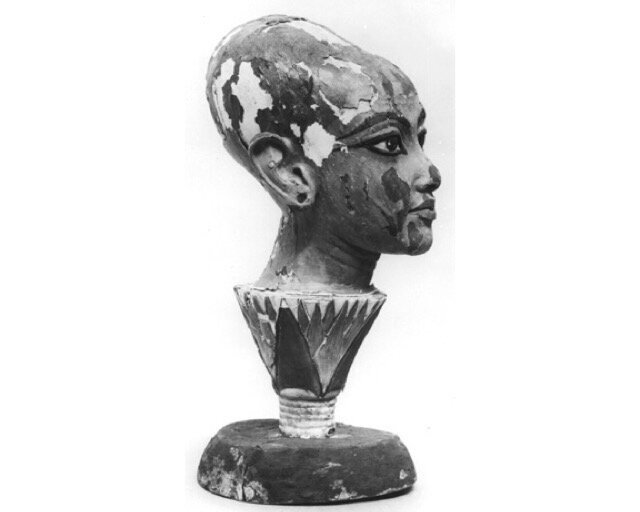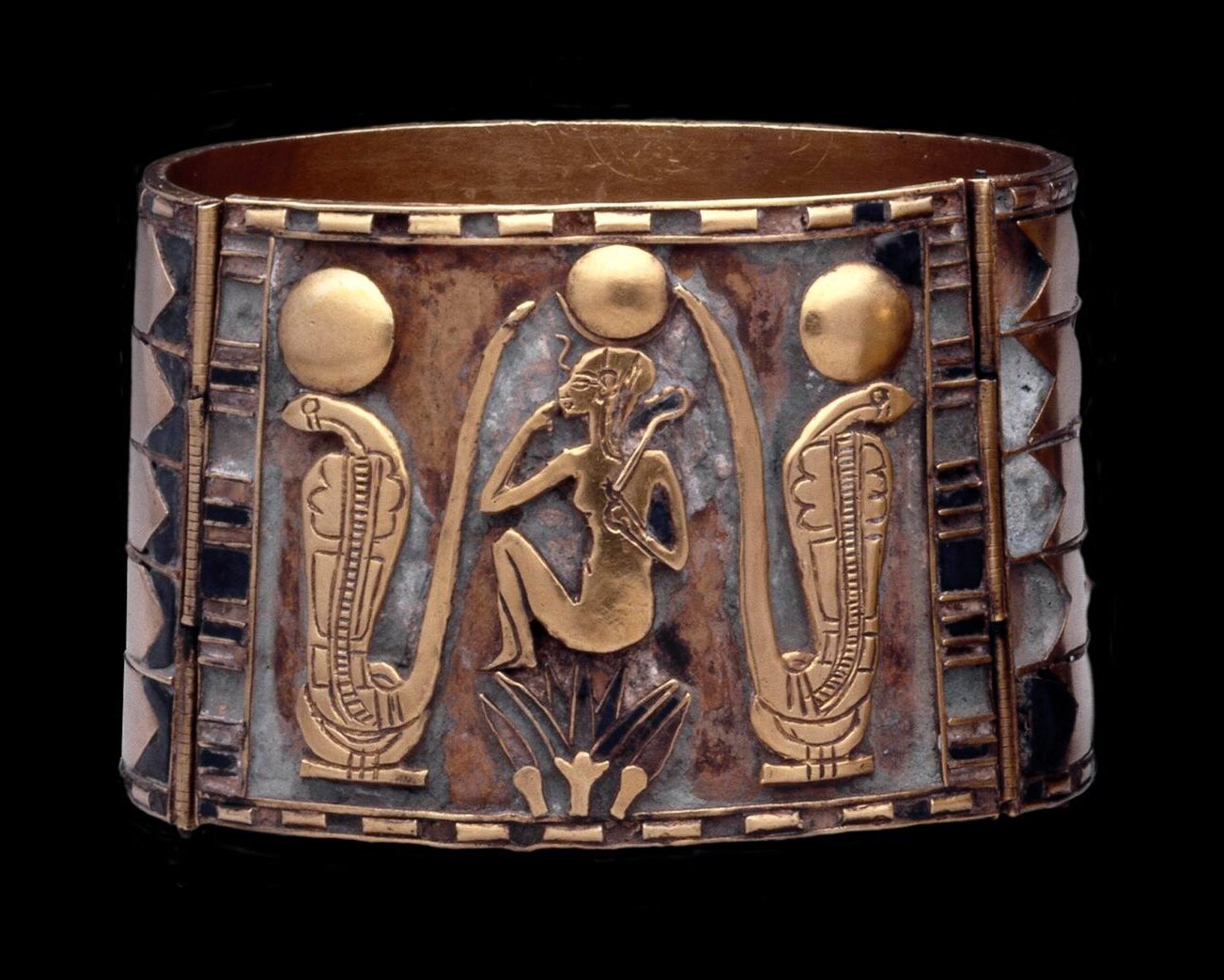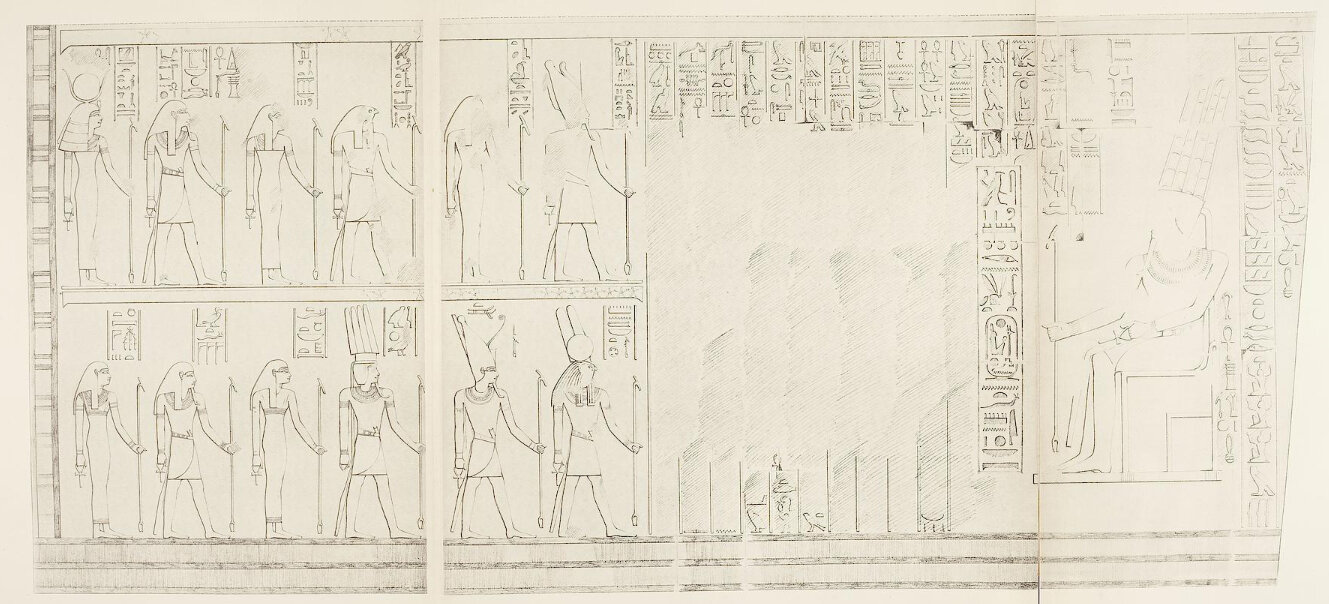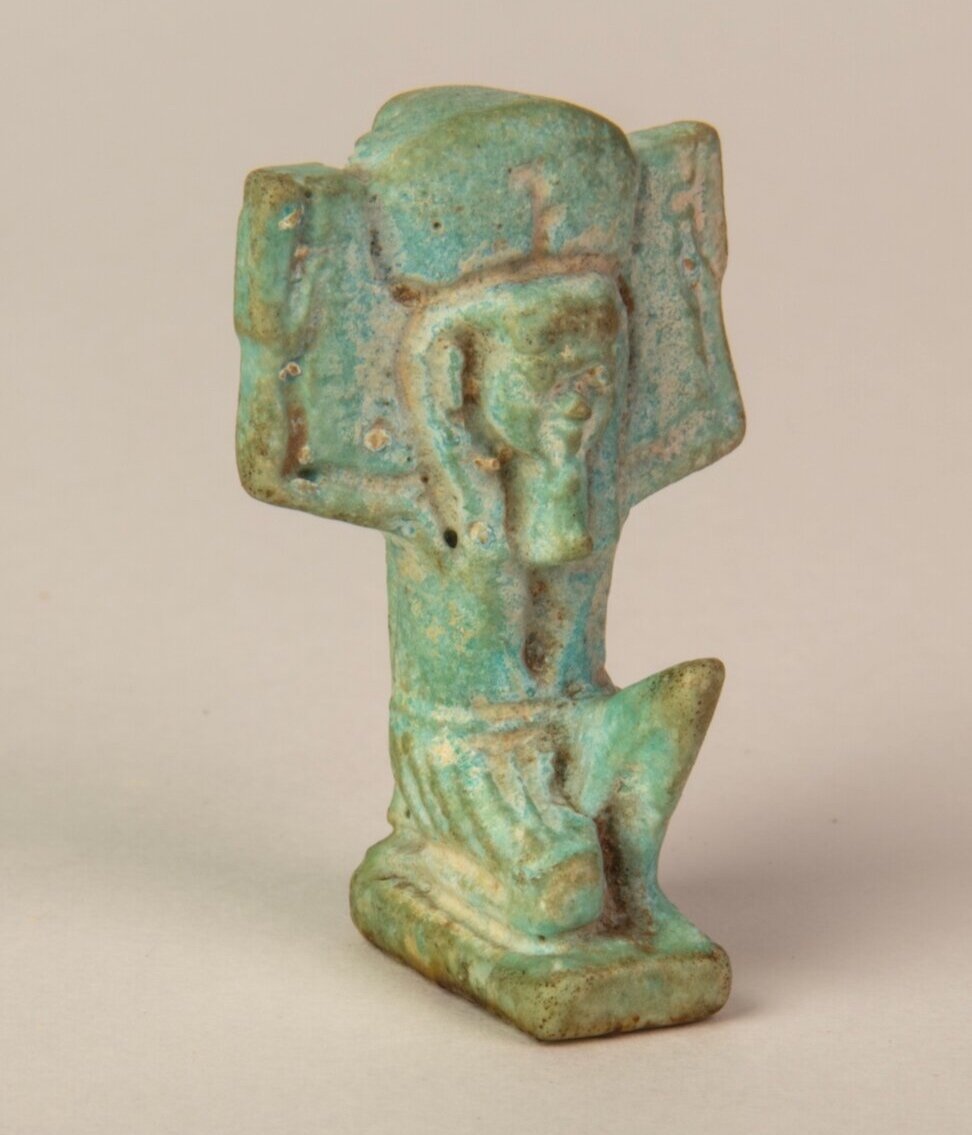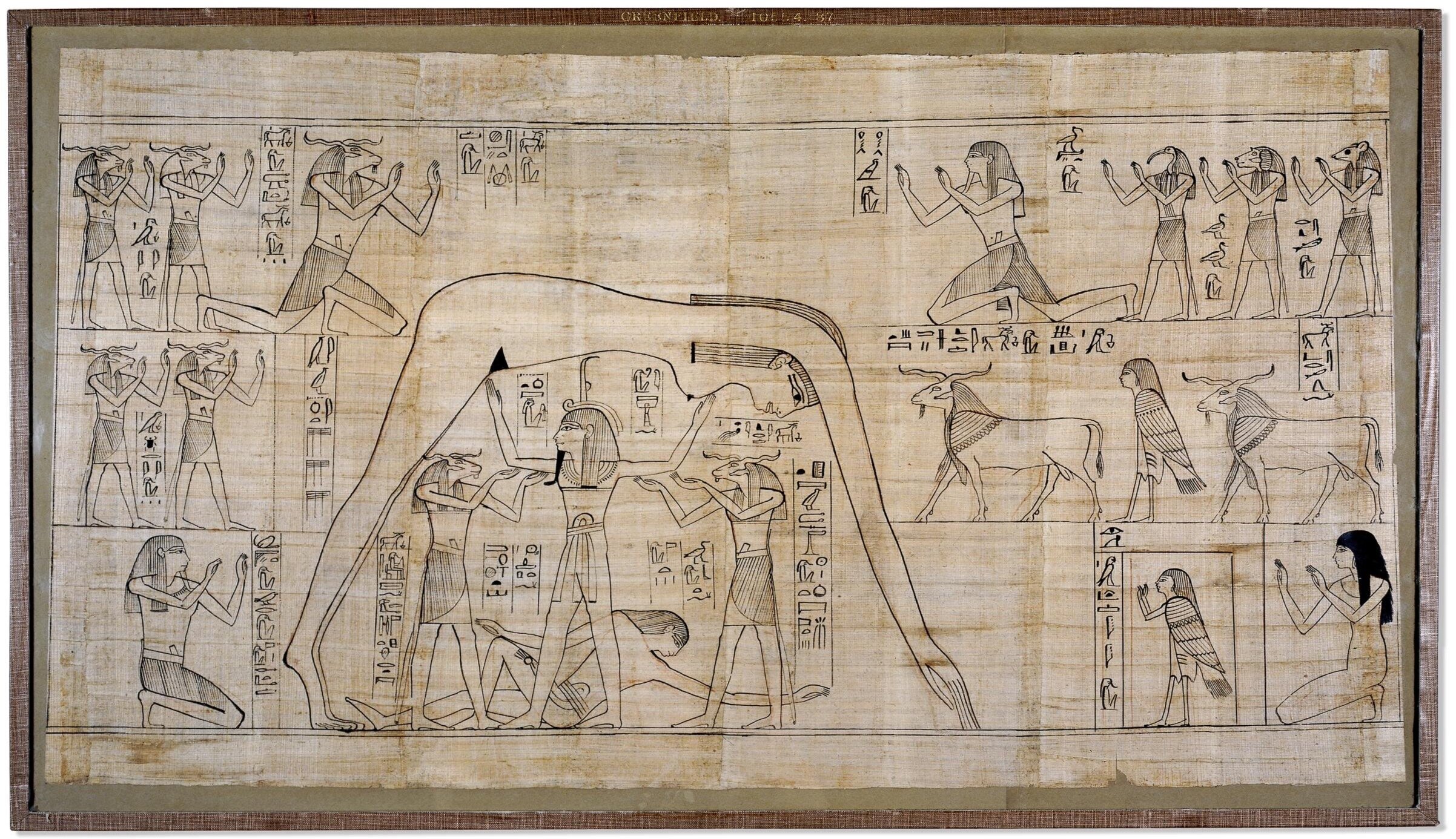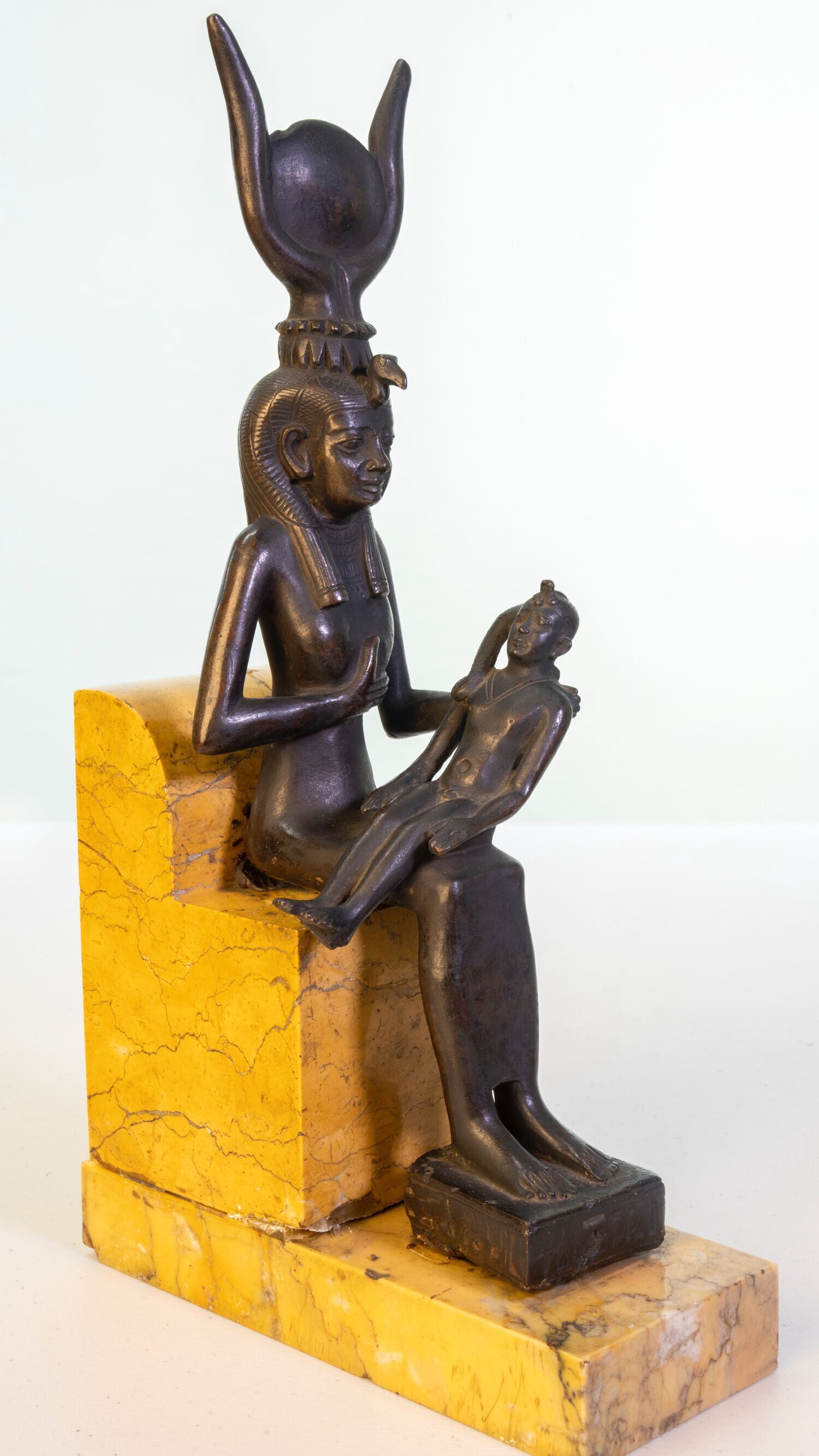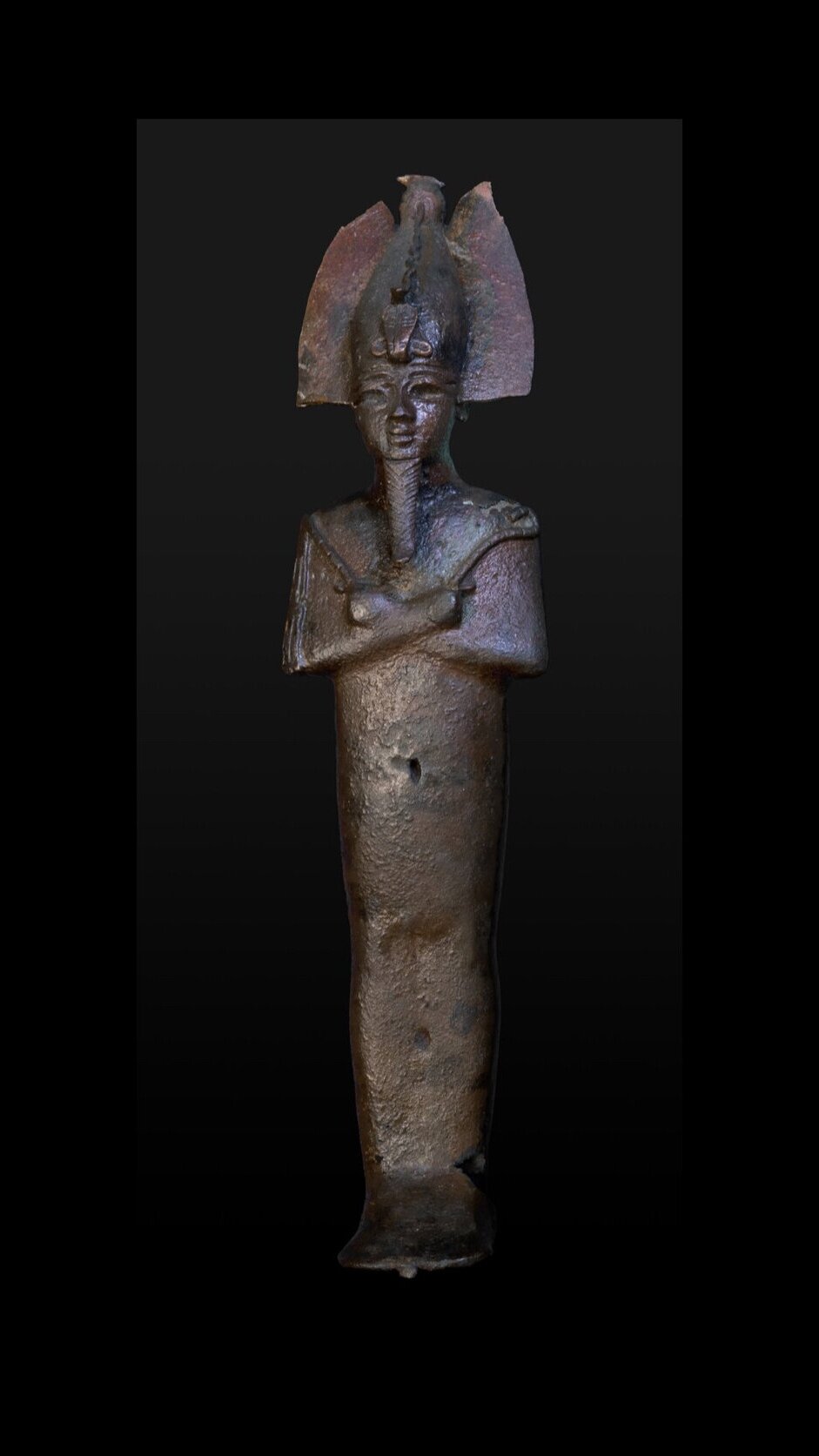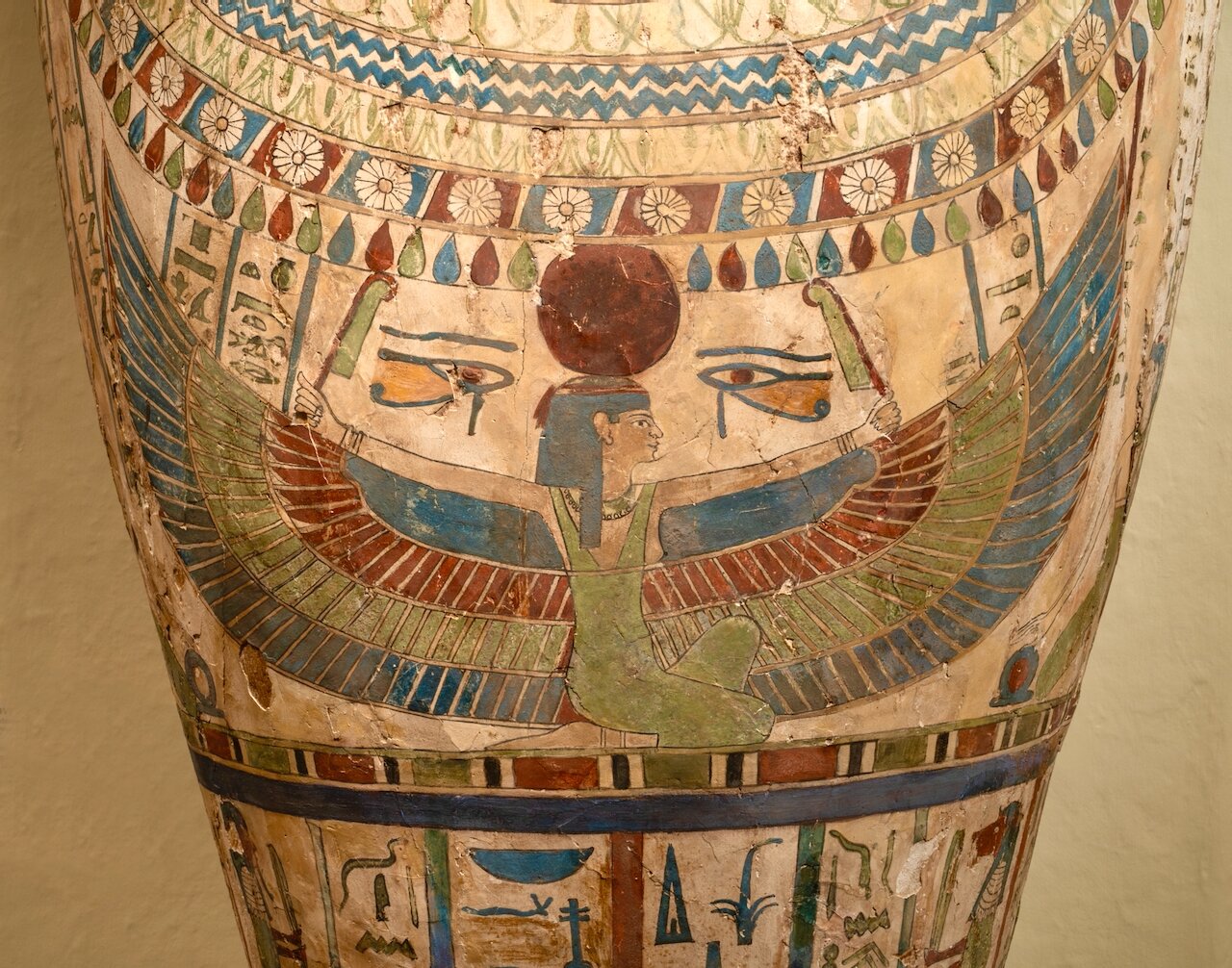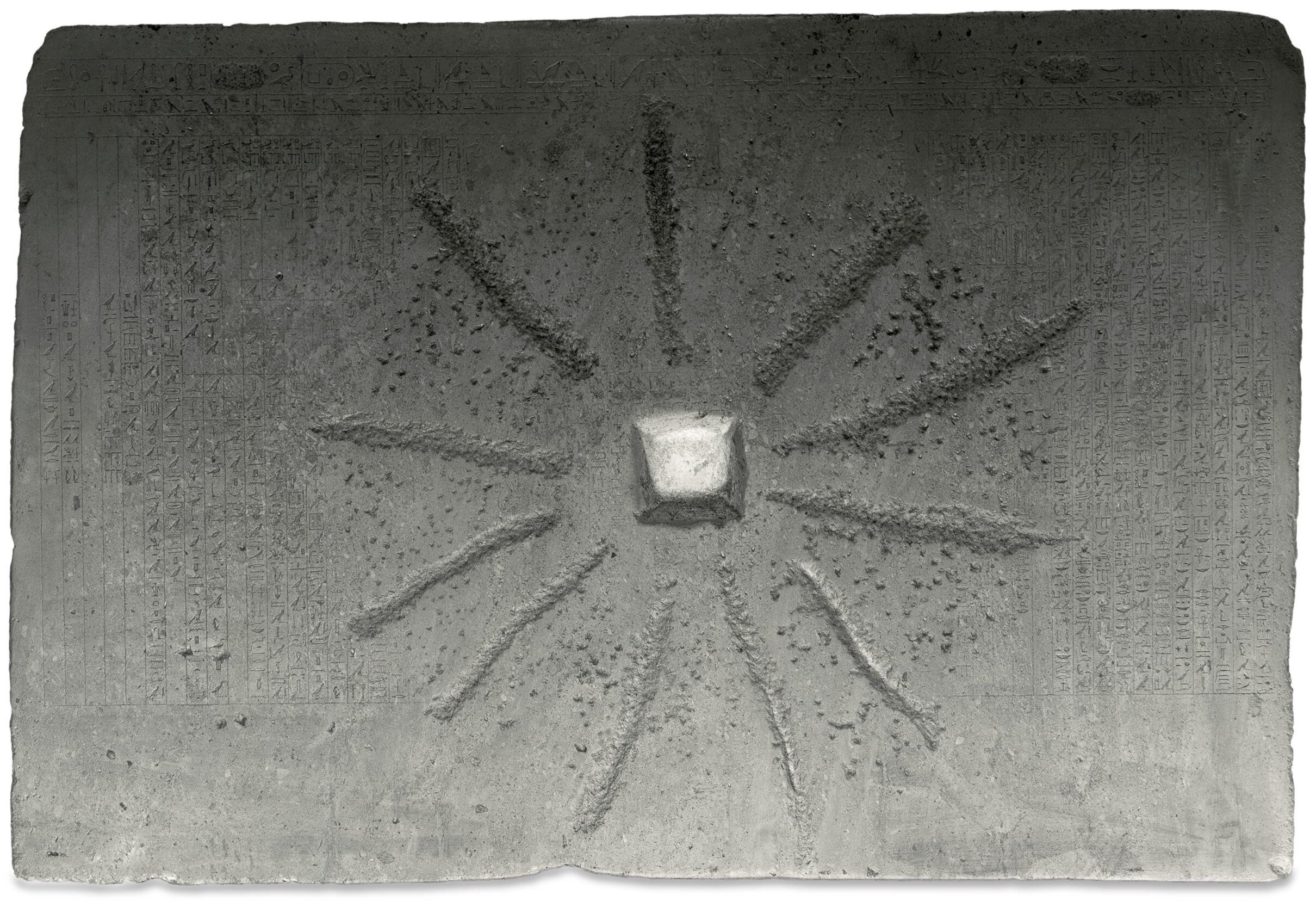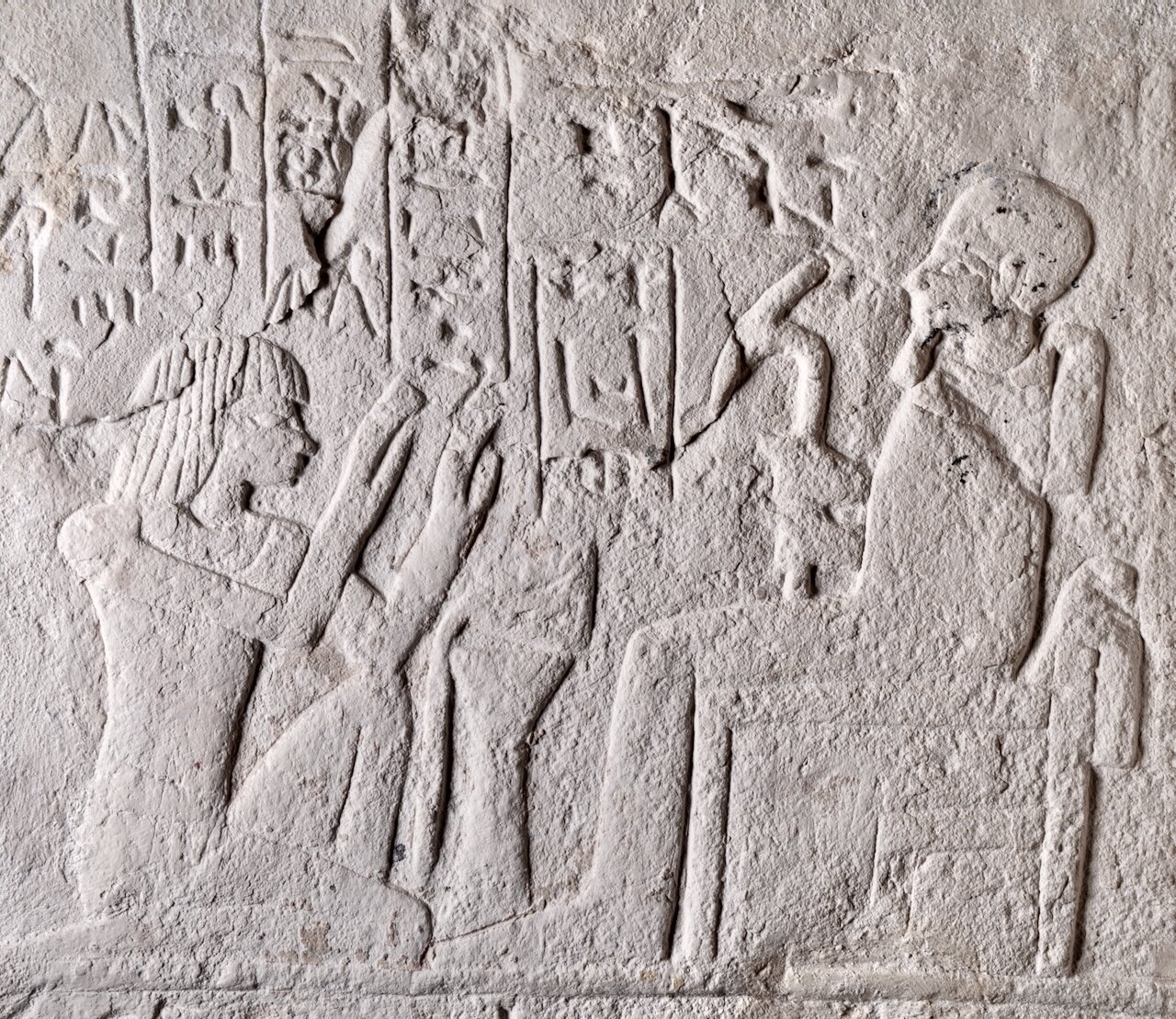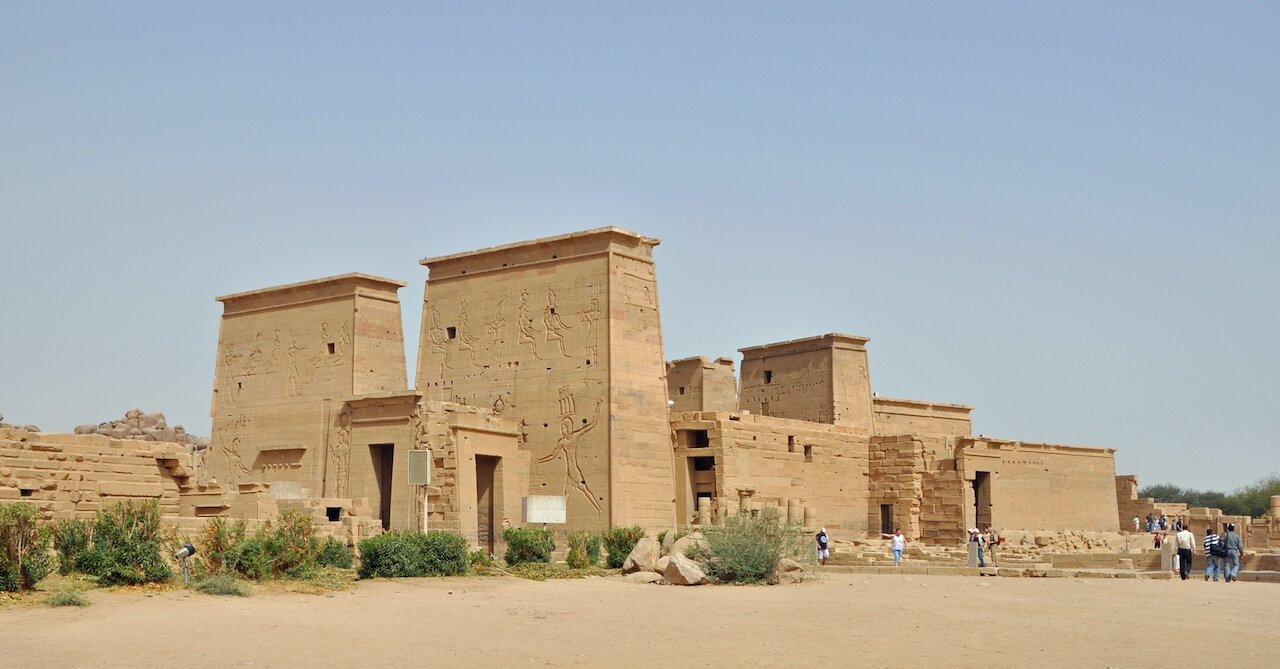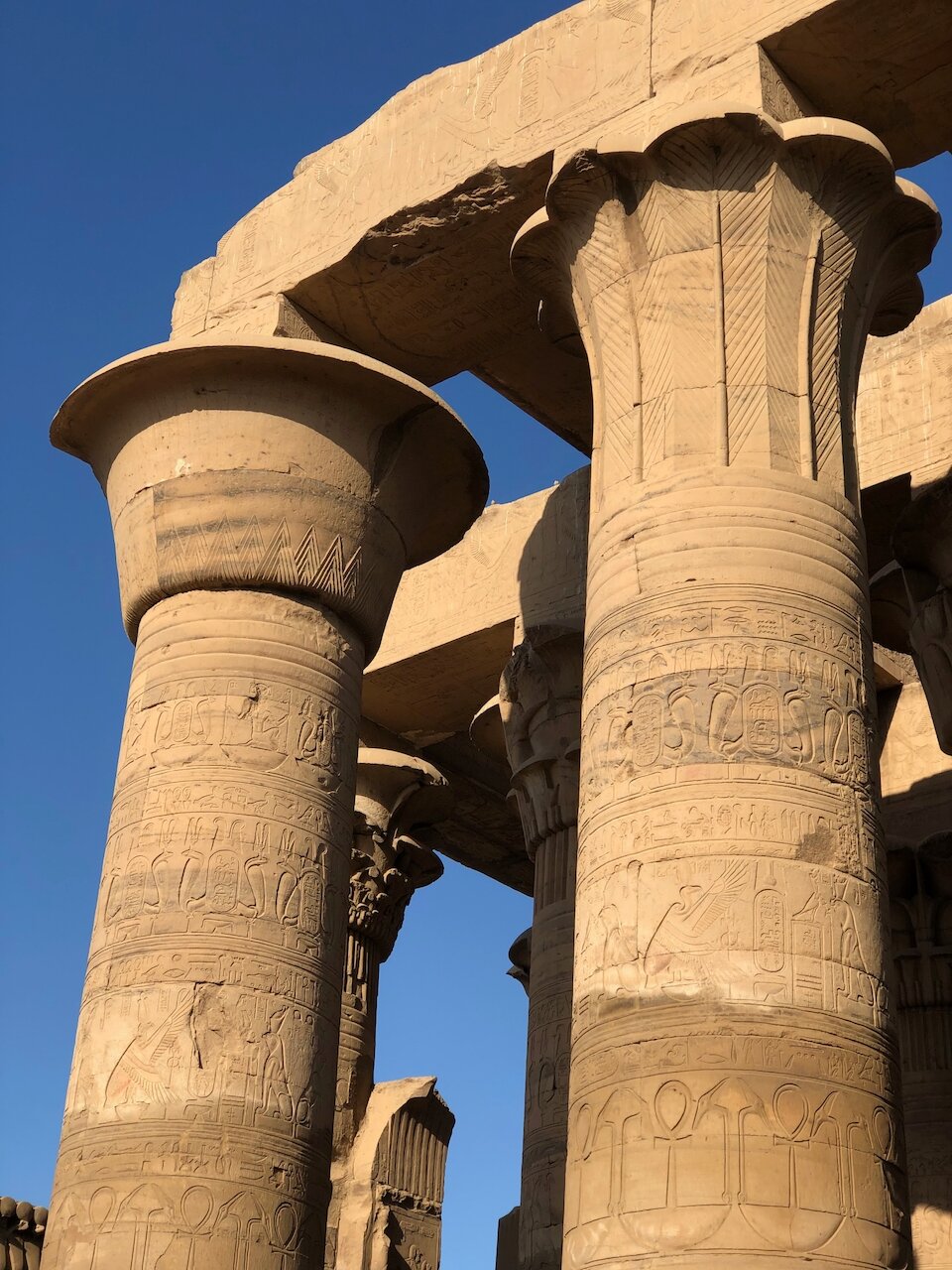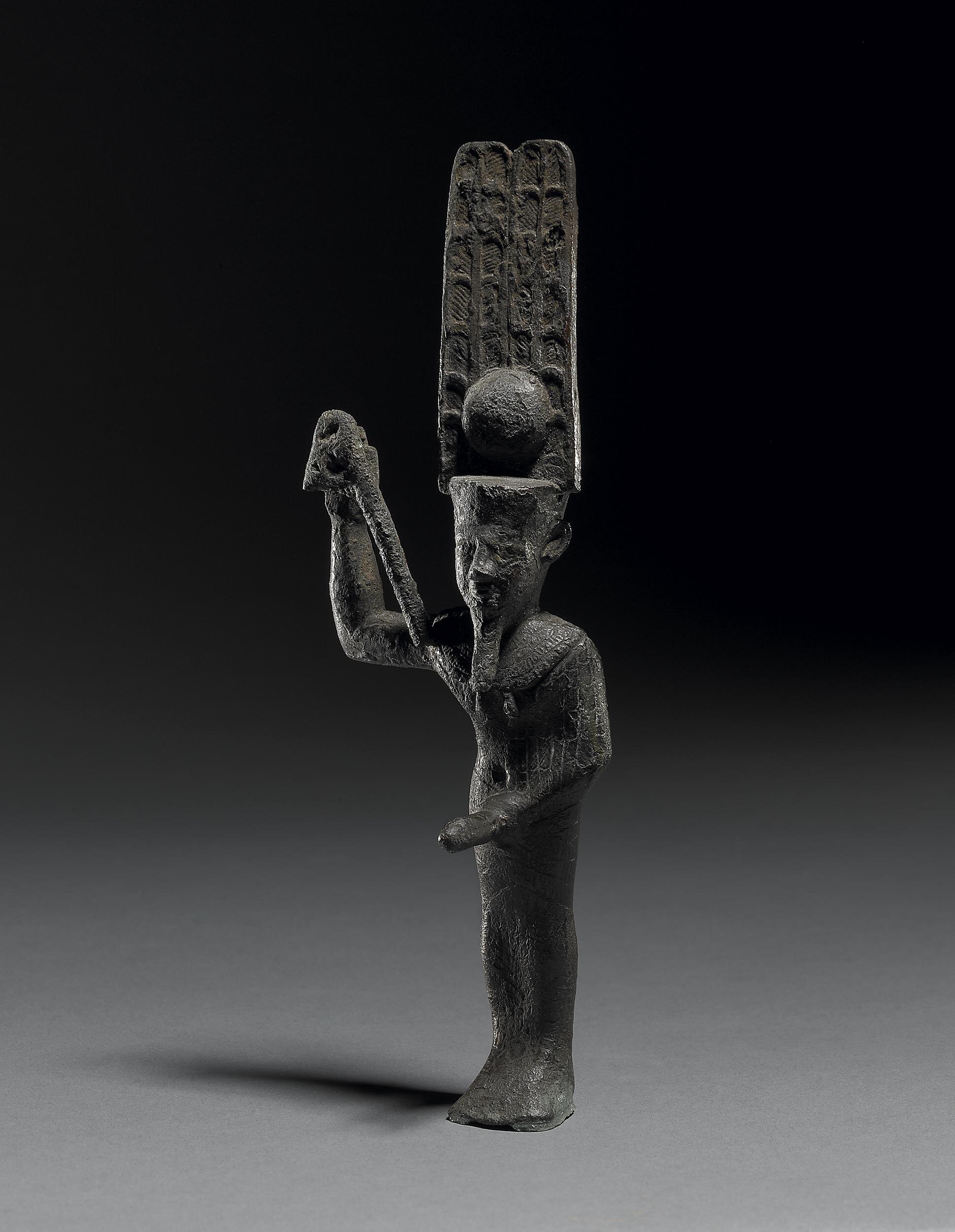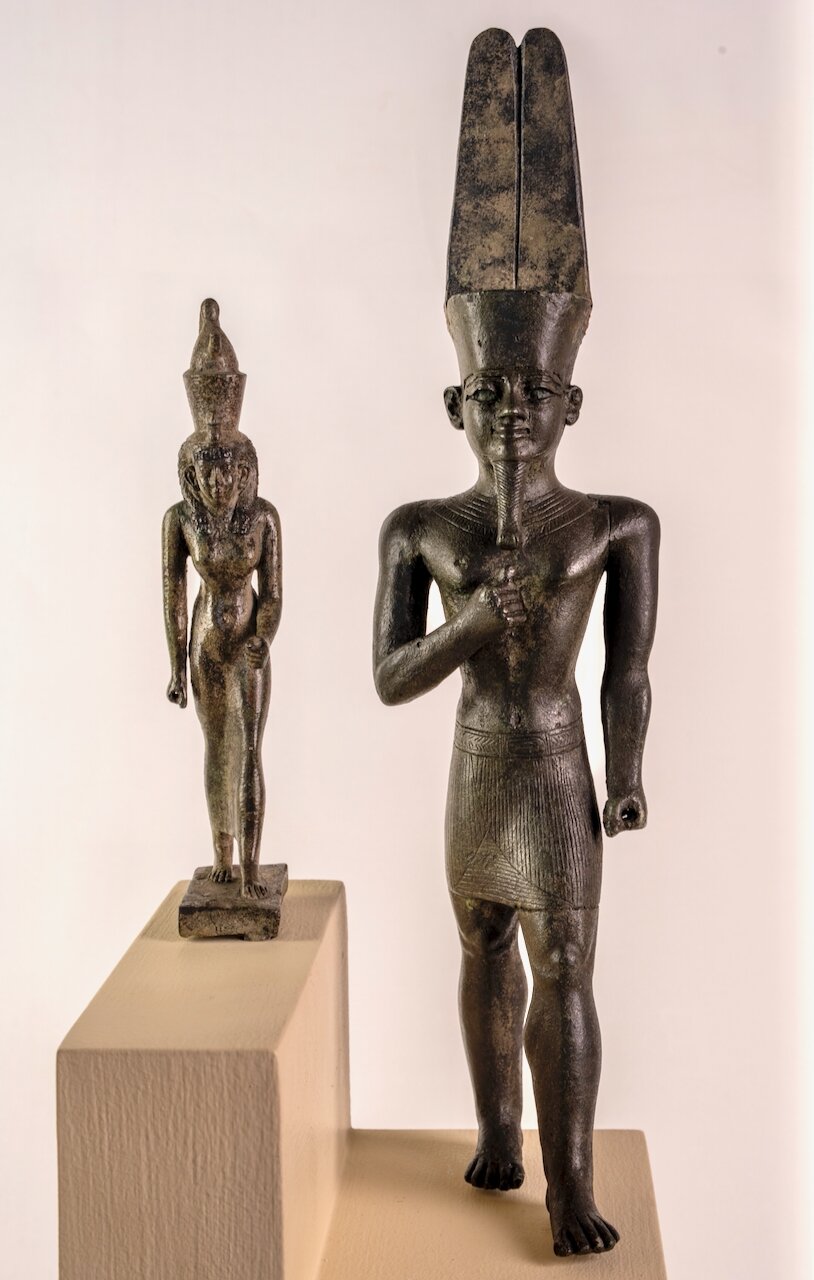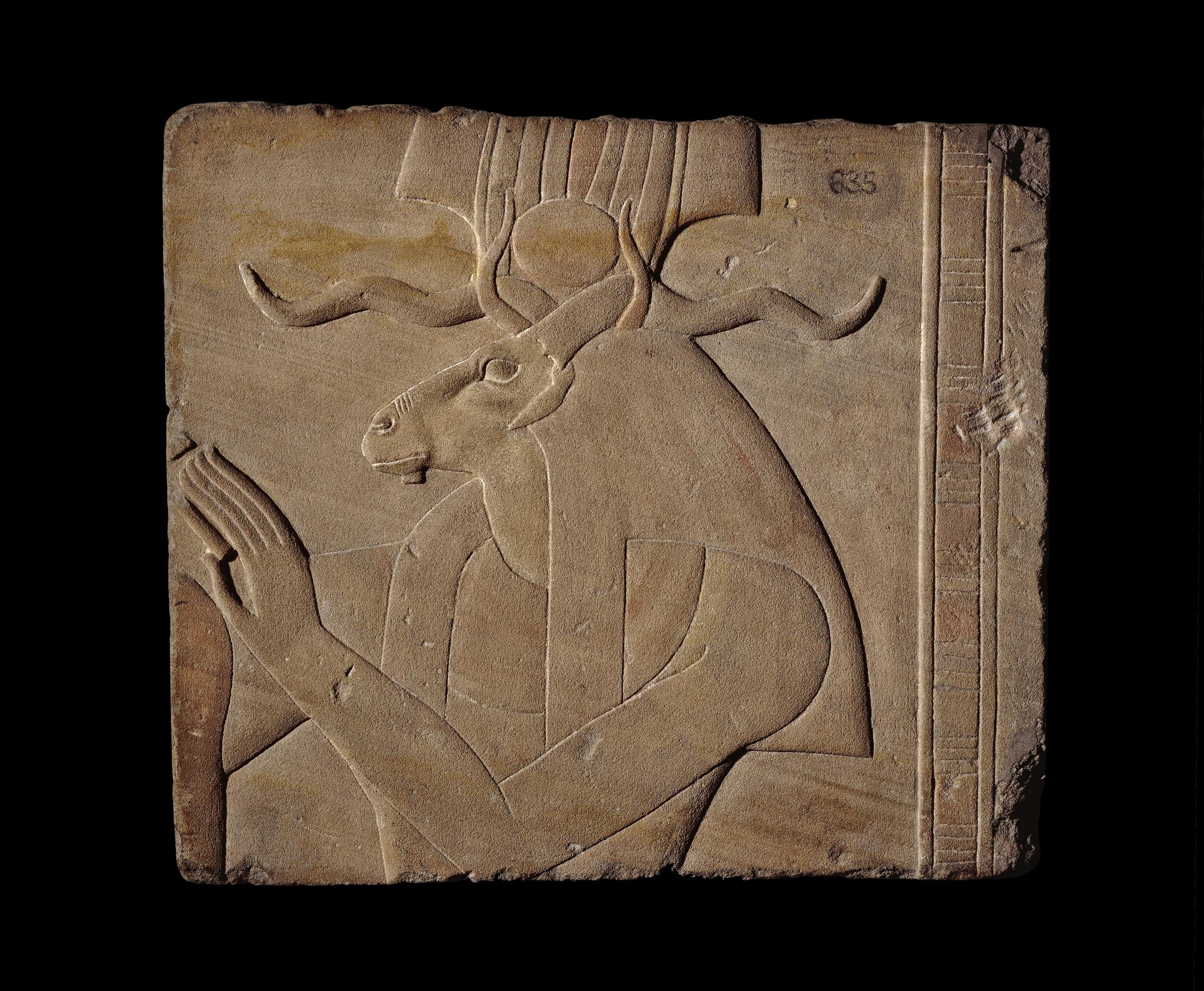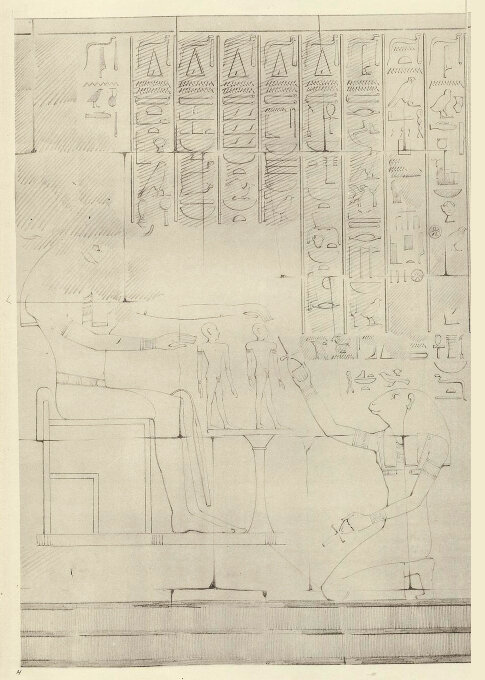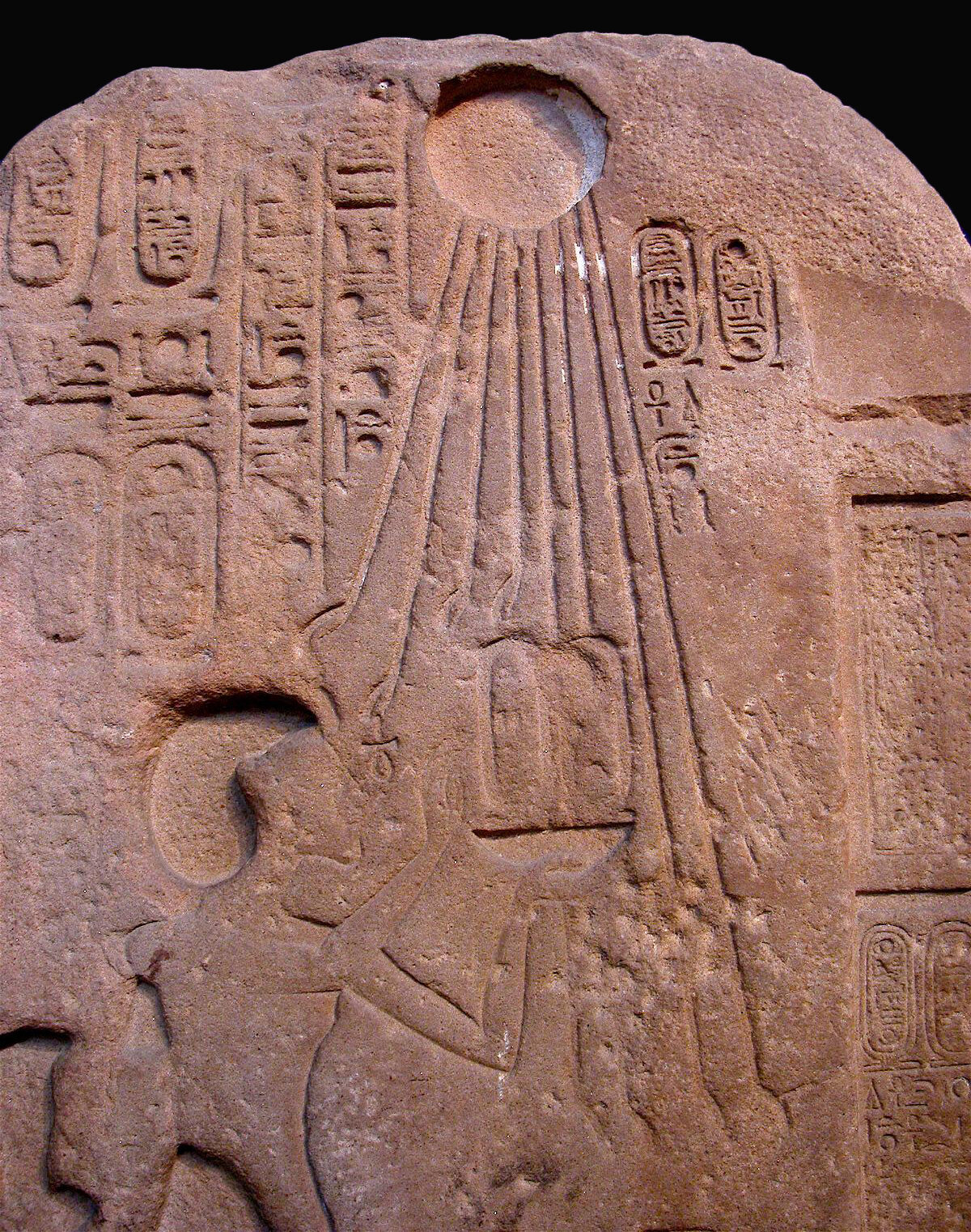Glencairn Museum News | Number 5, 2021
In the single column of text on the back of this faience figurine of Ptah, the god is recognized as a creator god and referred to as “the one who made heaven and who gave birth to craftsmanship.” The text further tells us that Ptah will offer life, prosperity, health, and all happiness to the owner/dedicator of the statuette.
The Egyptian pantheon was filled with deities who inhabited the heavens but whose influence was experienced on earth. In the Pyramid Texts of the Old Kingdom, which first appeared on the interiors of the pyramids of the kings of the Fifth Dynasty of the Old Kingdom (c. 2500–2350 BCE), we learn that the Egyptians regarded the sky as a dwelling place of their gods and a location connected to the afterlife. Just as their daily life depended upon the Nile River, the Egyptians envisioned this heavenly realm as a landscape that divine beings navigated in sacred boats (Figure 1).
Figure 1. A scene of the divine figures in a solar boat from the stela of Pebeh (EA8466). Image © The Trustees of the British Museum.
Figure 2. The falcon-headed sun god Re is adored by the priest Diefankh (UPMAA E2044). Image courtesy of the Penn Museum.
The sun god, Re, was of paramount importance to the ancient Egyptians, and the sun’s daily passage from east to west and its daily rising and setting served as a metaphor for the cycle of life—from birth, to adulthood, to death, to rebirth (Figure 2). The omnipresent sun in what was largely a desert environment may also explain the early Egyptians’ interest in solar concepts. At dusk, the sun god proceeded into the underworld (the Duat). New Kingdom funerary texts (1292–1075 BCE) and the associated images found on the walls of royal tombs record his nighttime journey. The sun god spent the twelve hours of the night traveling in the underworld, ultimately merging with Osiris, the primary funerary deity. The journey was treacherous, and the sun god faced his enemy, Apophis, a serpent who threatened him as he traveled in his solar boat nightly.
Another of Re’s important roles was as a creator god. The sun’s reappearance on the horizon at dawn each day was a symbol of the re-creation of the world. However, Re was not the sole creator god in Egyptian mythology. The Egyptians had several elaborate myths describing the origins of their world. Each of these creation stories was centered at a different city in ancient Egypt (Figure 3).
Figure 3. Map of Upper and Lower Egypt.
The Hermopolitan cosmology arose at the site of Hermopolis in Middle Egypt. Hermopolis was a city sacred to Thoth, the god of wisdom. The ancient Greeks equated Thoth with their god Hermes, which gives us the name Hermopolis, or “city of Hermes.” The ancient Egyptian name for this city was Khemnu, or “Eight-Town.” The number eight in this place-name makes references to the eight deities (the Ogdoad) who are the main characters in this version of the creation story. The Ogdoad consisted of four frog-headed male gods and their serpent-headed female counterparts (Figure 4). This divine group represented the dark, watery, unknown, and eternal state of the cosmos prior to creation. Nun and Naunet represented water. Heh and Hauhet expressed the notion of infinity. Kek and Kauket stood for darkness. Amun and Amaunet reflected the concept of hiddenness. These eight gods existed within the watery chaos of pre-creation.
Figure 4. An illustration of the Ogdoad, drawn by Faucher-Gudin from a photograph by Béato.
Within this unchanging “nothingness,” there was the potential for creation. The Egyptians believed that from these eight gods came a cosmic egg that contained the deity responsible for creating the rest of the world, including the primeval mound—the first land to arise out of the waters of pre-creation. In some versions of the myth, the egg was laid by a goose named “the Great Cackler,” while in other versions an ibis, the bird associated with the god Thoth, is responsible for the egg (Figures 5-6). Thoth’s appearance here in the myth is probably the work of the Hermopolitan priesthood, who wanted to recognize the importance of the city’s patron deity. After the mound appeared, a lotus blossom bloomed signaling the birth of the newborn sun god (Figure 7). After the sun made its first appearance, the rest of creation could follow. In some cases, this myth further describes a scarab beetle that emerges from the lotus. The scarab is often a solar symbol, and the texts describe how this beetle transforms into a child. When this child cried, his tears became humankind (Figure 8).
Figure 5. An amulet representing the god Thoth as an ibis-headed man (Glencairn Museum E219).
Figure 6. A bronze statuette representing the god Thoth as an ibis (Glencairn Museum E1121).
Figure 7. In this statuette from the tomb of Tutankhamun, the boy king is shown as the newborn sun god emerging from a lotus flower at the moment of creation (Cairo Museum JE 60723). Image courtesy of the Griffith Institute.
Figure 8. On this bracelet of Nimlot, the newborn sun god is shown as a child seated atop a lotus flower (EA14595). Image © The Trustees of the British Museum.
The importance of the sun in the creation of the world is highlighted in another creation myth that makes reference to a collective of gods known as the Heliopolitan Ennead (Figure 9). These nine deities (the Ennead) are mentioned in the Old Kingdom Pyramid Texts. This myth seems to have originated at the city of Iunu (or Heliopolis, meaning “City of the Sun” in Greek). Here, the creation of the world begins with a creator god named Atum (or Re-Atum). Just as we see with the Hermopolitan version of creation, there is a chaotic, watery state of pre-creation, in which Atum resides before he is born. Atum is self-created and arises in the shape of an obelisk-like pillar (the benben) in Heliopolis. He engenders by means of his own bodily fluids. To begin the creation of the world, Atum spits out a pair of divine beings: Shu, the god of air, and Tefnut, his female counterpart, the goddess of moisture (Figure 10).
Figure 9. An illustration of a relief from the mortuary temple of Hatshepsut at Deir el Bahri showing the members of the Ennead before Amun Re. This drawing appears in E. Naville, The Temple of Deir el Bahari, volume 2, London: Egypt Exploration Fund, 1896, pl. xlvi.
Figure 10. A faience amulet of the god Shu shown with upraised arms lifting up the sky (Glencairn Museum E453).
Shu and Tefnut in turn produce a second generation of gods. Their son, Geb, is the god of the earth, and his sister-wife, Nut, is the sky goddess. With this second generation, the Egyptian cosmos comes into existence and all the elements necessary for life on earth—the sun, air, moisture, land, and sky—are now in place. The iconography of Geb and Nut together is particularly evocative (Figure 11). Geb appears as a human male lying on the ground. Arched above him, separated by their father Shu, stretches the figure of his sister-wife Nut, often shown as a nude female whose body is covered in stars. The Egyptians envisioned her arms and legs as the pillars of the sky and each of her limbs as indicators of the four cardinal points. Before their separation by their father, Geb and Nut were able to produce another generation of gods: Isis, Osiris, Seth, and Nephthys. Isis (Figure 12) and Osiris (Figure 13) in turn produced Horus. (It is interesting to consider that the Heliopolitan genealogy can also be viewed as the family tree of the Egyptian king (Figure 14). Each king was considered a representative of Horus while he was alive, and was then associated with the god Osiris, the king of the dead, after his death.)
Figure 11. The Egyptian version of the cosmos as seen on this drawing from the Book of the Dead of Nestanebetisheru. Here Shu, the god of air, separates the earth god Geb from the sky goddess Nut (EA10554,87). Image © The Trustees of the British Museum.
Figure 12. Figurine of Isis, member of the Heliopolitan Ennead, suckling Horus (Glencairn Museum E1164).
Figure 13. Figurine of Osiris, member of the Heliopolitan Ennead (Glencairn Museum E74).
Figure 14. The family tree of the Heliopolitan Ennead.
In addition to their roles in the creation of the cosmos, members of the Ennead are involved in other cycles of life and rebirth. For example, the sky goddess Nut is believed to give birth to the sun each day, and in some traditions she also gives birth to the stars. When observing the nighttime sky, the Egyptians may have noticed that the outer arm of the Milky Way resembled a female form and identified this celestial feature with the goddess Nut. As a goddess responsible for the sun’s daily rebirth, Nut was also accorded a role in the resurrection of the dead. Representations of Nut on the ceilings of New Kingdom (1539–1075 BCE) royal tombs show the goddess with the sun entering her mouth and passing through her star-covered body during the night, to be reborn in the morning. She often appears on the inside lids of sarcophagi, protecting the deceased until he or she, like the sun god Re, would be reborn. Nut can also appear on the lids of coffins as a woman with wings spread protectively across the chest of the deceased (Figure 15).
Figure 15. The goddess Nut on the lid of the coffin of Sema-tawy-iirdis (Glencairn Museum E1267).
A third version of the creation of the cosmos can be found in a text known as the Memphite Theology. Memphis was one of the most important cities in ancient Egyptian history. Situated along the Nile at the point where the Nile River branches out into the Nile Delta, Memphis was Egypt’s first capital city. Throughout Egypt’s long history, Memphis remained an important religious and administrative center even during times when its status as the country’s capital city had shifted. According to the historian Manetho, Memphis was founded by the legendary king Menes around 3200 BCE. The divine triad who protected the city consisted of Ptah, his consort Sekhmet, and their child, Nefertem (Figure 16). Ptah was the patron deity of craftsmen, and in the Memphite version of creation he plays the role of the primary creator god (see also lead photo above).
Figure 16. Members of the Memphite triad, the patron deities of Memphis (Glencairn Museum E113, E967, E905).
Unlike the versions of creation expressed in the Hermopolitan and Heliopolitan creation myths, which have been reconstructed from various ancient religious texts, the Memphite creation myth is preserved on a single document known as the Shabaka Stone, which is now preserved in the British Museum (Figure 17). The text inscribed on this monument relates how King Shabaka, a Nubian pharaoh of Egypt’s 25th Dynasty (705–690 BCE), found a worm-eaten papyrus in the library of the Temple of Ptah at Memphis. Realizing how important the damaged document was, Shabaka purportedly ordered that the words be carved anew in stone to preserve them. In this text Ptah (Figure 18) is credited with the creation of the world. He creates by means of thought and words: “Sight, hearing, breathing—they report to the heart, and it makes every understanding come forth. As to the tongue, it repeats what the heart has devised. Thus all the gods were born and his Ennead was completed. For every word of the god came about through what the heart devised and the tongue commanded.” The text describes how Ptah was responsible for the creation of all the gods and the establishment of their worship throughout Egypt:
“He gave birth to the gods.
He made the towns,
He established the nomes,
He placed the gods in their shrines,
He settled their offerings,
He established their shrines,
He made their bodies according to their wishes.
Thus the gods entered into their bodies,
Of every wood, every stone, every clay,
Everything that grows upon him
In which they came to be.
Thus were gathered to him all the gods and their kas,
Content, united with the Lord of the Two Lands.”
Figure 17. The Shabaka Stone, a basalt slab inscribed with the text of the Memphite Theology. The stone was later used as a millstone, which explains some of the damage to its surface (EA498). Image © The Trustees of the British Museum.
Figure 18. A representation of the god Ptah on the stela of Maienhekau (Glencairn Museum E1266). Ptah is shown with his characteristic skull cap.
Reference to the moment of creation is not only seen in Egyptian texts. Most temples have architectural features that mimic elements of the cosmos at the beginning of creation. A large gateway called a pylon usually fronts a temple (Figure 19). The form of the pylon consists of two tapering towers joined by a lower section. The shape of the pylon imitates the hieroglyph for the word “horizon” (akhet), represented as two hills with a sun disk in the center. Further adding to the solar imagery, a pair of obelisks often stands before the entrance to the temple. An obelisk is a four-sided standing stone that tapers as it rises and ends in a small pyramid called a “pyramidion.” Obelisks were sacred to the sun god and were a symbol of the sun related to the benben, which calls to mind the primordial mound described in the Heliopolitan and Hermopolitan creation myths.
Figure 19. A view of the temple pylon at Philae Temple. Photo courtesy of Marc Ryckaert.
Figure 20. A view of papyriform and lotiform columns in the temple of Kom Ombo. Photo courtesy of Marie Thérèse Hébert & Jean Robert Thibault.
Each temple was a microcosm of the world wherein the creation was repeated on a daily basis. Beyond the entrance pylon, the typical temple contained one or more open courts, a hypostyle hall, and, at the innermost space, the sanctuary. The columns found throughout the temple often had capitals that are papyriform or lotiform in design, echoing the marshy plants that emerged on the primeval mound (Figure 20). The dark sanctuary or shrine that housed the image of the temple’s resident god imitated the mound upon which creation began. When priests carried out the morning rituals and opened the god’s shrine, they reenacted the very moment of creation, and the temple’s resident deity took the position of the creator god. Many temple precincts are also bounded by walls whose bricks are laid in a wavy design, perhaps symbolizing the chaotic waters of pre-creation which are held at bay by the creation of the (primordial) mound upon which the temple structure was built.
In addition to the creator gods depicted in the three main creation myths, there are other deities who were also considered creator gods such as Min, Amun, Khnum, and the Aten. One of Egypt’s earliest known deities was the god Min (Figure 21). Depictions of him appear as early as the Predynastic Period. Three colossal statues of Min dating to around 3300 BCE were excavated by W.M.F. Petrie at the site of Coptos. These statues, while fragmentary, originally depicted this god with the erect phallus that became standard for his representations. As a god connected with fertility and creation, Min is usually shown in this distinctive ithyphallic pose. He grasps a flail in one upraised arm and wears a tall plumed crown very similar to that of Amun-Re.
Figure 21. The god Min (EA60045). Image © The Trustees of the British Museum.
A member of the Hermopolitan Ogdoad, Amun’s name means “the hidden one.” During the Middle Kingdom (c. 1945-1640 BCE) this god became increasingly important, and by the New Kingdom he rose to prominence as a state god and was given the epithet “king of the gods.” Amun, together with his consort Mut, and their child, Khonsu, comprise the Theban triad, the patron deities of the city of Thebes (Figure 22). At the same time, Amun (or his combined form, Amun-Re) became thought of as a creator god in his own right. Amun was usually shown as a human, and when he was in the form of Amun-Re he wore a crown with two tall plumes. The ram and the goose were animals sacred to him.
Figure 22. A bronze statuette of the god Amun (right, Glencairn Museum E1165) and his consort Mut (Glencairn Museum E1145).
The ram-headed god Khnum is described in the Coffin Texts, a collection of funerary spells composed around 1991-1786 BCE, as a creator of humans and animals (Figure 23). By the reign of the female pharaoh Hatshepsut (reigned 1479-1458 BCE), Khnum is described as a god who is responsible for fashioning gods, humans, and animals on a potter’s wheel (Figure 24).
Figure 23. Relief showing the ram-headed god Khnum (EA635). Image © The Trustees of the British Museum.
Figure 24. An illustration of a relief from the mortuary temple of Hatshepsut at Deir el Bahri showing Khnum creating Hatshepsut and her ka on a potter’s wheel. This drawing appears in E. Naville, The Temple of Deir el Bahari, volume 2, London: Egypt Exploration Fund, 1896, pl. xlviii.
Figure 25. The Aten appears at the top of this relief fragment above a figure of King Akhenaten. Unlike other Egyptian deities, the Aten does not take a human or animal form. This deity is shown as a sun disk with rays that end in tiny hands (UPMAA E16230). Image courtesy of the Penn Museum.
During the Amarna Period, when the pharaoh Akhenaten (reigned 1353-1336 BCE) changed the religious system from a polytheistic one to one that approached monotheism, his chosen deity, the Aten, naturally took position as creator god (Figure 25). The Aten was a solar deity, and his role in creation is celebrated in hymns composed during this period. In one version, the Aten is praised and described as follows. (It is interesting to note that scholars have long observed the similarity of this hymn to the phraseology of Psalm 104 in the Bible):
“How numerous are your works, though hidden from sight.
Unique god, there is none beside him.
You mold the earth to your wish, you and you alone.
All people, herds and flocks,
All on earth that walk on legs,
All on high that fly with their wings.
And on the foreign lands of Khar and Kush, the land of Egypt
You place every man in his place,
you make what they need,
so that everyone has his food,
his lifespan counted.”
This religious experiment did not last long beyond the death of Akhenaten. By the beginning years of the reign of Tutankhamun, the traditional religious system with its many gods had been restored and the Aten returned to being just one of many solar deities in the Egyptian pantheon.
As we can see, there was no one single creation story in Egyptian religious tradition. There were several different ways in which the Egyptians explained the origin of the world. These various traditions were not mutually exclusive. They often complimented and intersected each other, yet distinctions can be drawn amongst the various creation myths, which helps to distinguish one from the other.
Jennifer Houser Wegner, PhD
Associate Curator, Egyptian Section, Penn Museum
University of Pennsylvania
Select Bibliography
Andrews, Carol. 1994. Amulets of ancient Egypt. London: The British Museum Press.
Lichtheim, Miriam. 1976. Ancient Egyptian literature: a book of readings. Vol. 2. The New Kingdom. Berkeley/London.
O’ Rourke, Paul. 2001. “Khnum.” In Donald B. Redford (ed.). The Oxford Encyclopedia of Ancient Egypt, vol. 2: 231-232. Oxford: Oxford University Press.
Romanosky, Eugene. 2001. “Min.” In Donald B. Redford (ed.). The Oxford Encyclopedia of Ancient Egypt, vol. 2: 413-415. Oxford: Oxford University Press.
Schlögl, Hermann A. 2001. “Aten.” In Donald B. Redford (ed.). The Oxford Encyclopedia of Ancient Egypt, vol. 1: 1156-158. Oxford: Oxford University Press.
Simpson, William Kelly (ed.) 2003. The literature of ancient Egypt: an anthology of stories, instructions, stelae, autobiographies, and poetry, third ed. New Haven; London: Yale University Press.
Tobin, Vincent A. 2001. “Amun and Amun-Re.” In Donald B. Redford (ed.). The Oxford Encyclopedia of Ancient Egypt, vol. 1: 82-85. Oxford: Oxford University Press.
Tobin, Vincent A. 2001. “Myths: Creation Myths.” In Donald B. Redford (ed.). The Oxford Encyclopedia of Ancient Egypt, vol. 2: 469-472. Oxford: Oxford University Press.
Wilkinson, Richard H. 2003. The complete gods and goddesses of ancient Egypt. London: Thames & Hudson.
A complete archive of past issues of Glencairn Museum News is available online here.
